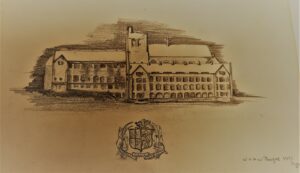
“The spiritual journey begins in exile” is a direct quote from a book by John Fortunato about his experience as a gay man in America. He used biblical images from the exile of Adam and Eve from creation’s perfection, to the journeys of the great characters of early Judaism like Abraaham and Sara.
First century Jews linked how Jesus, also on a journey, begins this pattern of exile to freedom. From an outhouse in Bethlehem to the cross, outside the city of Jerusalem, Jesus engages fully with the exiled of all shapes and sizes. Although Christianity has historically been damning of homosexuality, its institutional persecution and exile of millions of good people, including LGBT people, links us to this spiritual inheritance as sons and daughters of Abraham and Sara. No-one can take this away from us. We journey with them from exile to find our “home” as LGBT people. This journey takes a lifetime and Fortunato’s insight was to link this spiritual treasure as ours as well.
When Archbishop Desmond Tutu asked “Where in the Bible does it tell us God is a Christian?” Christian triumphalism is silenced. Instead of being weaponized against us, LGBT people need to see our journeys linked to a mysterious destiny where we are not fully in charge or fully at home. We have solidarity with other exiles who are no longer at home in their own skins or their own countries and are moving towards what Teilhard de Chardin imagined “the Omega point“. Persecuted by the Catholic church in the middle of the 20th century for being a scientist most of his ministry, Teilhard embraced both the exile and the journey and would become one of the key theologians to inspire awareness and action on climate change in the 21st century. Now he is quoted by Popes and Cardinals and they claim him without often acknowledging the church’s attitudes and behaviors that inhibited him. LGBT people have no unique claim to persecution or special status when it comes to exile and derision. For me, a belief that the mystery we call “God” was beckoning me to become a priest (even though I was gay) and I would meet obstacles and even persecution from the institutional church, did not deter me from this scary adventure. Am I good enough? Will someone want me? Can I finish this art that is quilting and weaving my life together, dyeing threads in colors that others may make into their own cloth, without sabotaging or despairing? These questions are always with us, whether we are beginning to splash colors onto a canvas or turn up for ordination in a profession that historically has demonized LGBT people. The church has a wonderful way of using our skills and experience as lay leaders or clergy while insisting we remain in various stages of closet-edness. There are a few exceptions to this in some churches, but the dominant theme is still spiritually destructive and somehow emerging from that lie and exile is the spiritual challenge of millions of human beings. I can understand why so many great and good people have left the church, but I had something else to live into and this reflective writing about my own exile and journey is helping me to see what could realistically be done, with all its inhibitions, limitations and opportunities. A work of art, no less a life, is an emerging living encounter with mystery and struggles to communicate something yet unborn, unrealized, not yet articulated. We need others to see, understand and appreciate all of it before we return to the clay of mother earth. Yet, we too are invited and destined to shape and form the clay ourselves, just like a God. This is the image of God (imago Dei) in our species.
Exiled to walk in another’s shoes
Exile may always seem about narcisistic us, but it may also break us open to the other’s reality. An 80 year old Republican Christian living in Jesusland USA, may feel just as exiled as I sometimes feel, from the land and community they once knew, but what do we do about it? Recreating an imaginary 1950’s or rolling back the industrial or sexual revolutions of the last 200 years wont help us either. I have been privileged to work and travel these difficult journeys with many different types of people over 45 years of ministry and embracing whatever exile we are experiencing is these secret and reluctant beginnings of a wonderful adventure. This journal reflects those challenges and gifts that we are to each other. if you have not read the first two chapter yets, here is a link: https://albertogle.com/art/the-art-of-coming-out/.
1972 -The Great Escape from Belfast
Three very happy years at university in North Wales had been very good for me academically and spiritually as I was preparing to go to seminary to serve in the Anglican Church of Ireland. It was good to have some respite from the “Troubles” back home and made some wonderful friendships. However, I was unable to come to terms with being gay, continued to date women and pretended I was straight. Pressure from family, the church and society as a whole made it fairly impossible to find myself and it was only after graduating and returning to Ireland after three years in Bangor, that I could get some perspective.
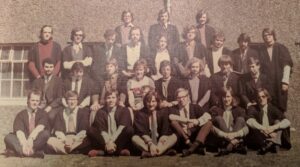
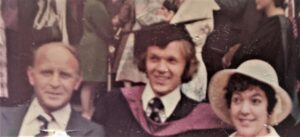
Gay Liberation
My parish priest’s son, Malcolm Macourt, was a lecturer in Durham University and was a leader in the Student Christian Movement in the UK. He co-authored a pamphlet on being gay and Christian and shared a copy with me, principally to get my support as he came out to me.
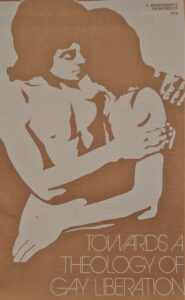
What he did not realize was how important the timing of this very rational collection of essays from some of the gay Christian leadership of the time, would have on my own coming out. When I thanked him and told him I was gay in late 1975, he invited me to come to Durham to meet some of his “normal gay friends”. I flew from Belfast to Newcastle just after Christmas and spent a week with him and it was there I met Frank Wilson and his lovely family. Patsy, his sister was married to another seminarian, Jonathan Adams and as Frank and I began a long distance relationship, this Durham connection would be life changing.
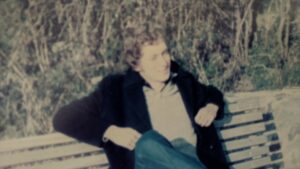
I returned to Trinity College, Dublin and the ultra-closeted world of the Church of Ireland Divinity School where I was augmenting my theological education with some pastoral studies, Irish Church history and liturgical and communication training. There were three full time staff at the seminary, in various stages of unspoken/suppressed gay identity, so the climate in the seminary was challenging for me, just beginning to crack open my own closet door. Had I come out, I would not have been ordained and the added stigma of being in a relationship with another man ensured this new double life would continue. Frank, still in Durham (and preparing for university in London) and I would correspond by letters (long beforoe e mails!) and when the head of the seminary turned up one day with a letter in hand saying rather coyly, “Another billet doux (love letter) Mr. Ogle?” I was terrified -was this a warning from the closeted Canon John Brown, or a friendly gesture to confide in him? Many in my generation and older thought it prudent to keep up this double life, allowing them to be ordained and work in parishes, with their wives (some knowing what they were getting into) support and often unacknowledged sacrificial ministries to countless congregations. As Anglicans, we were expected to be married and have our own children and families. Unlike the present climate of professional boundary-keeping between clergy and parishioners, in my day, it was customary for some local parish members to activity encourage dating and marriage between incumbent clergy and the young women of the parish. So the pressure to conform to a heterosexual norm, from the institutional church to the local parish, at all levels, was crushing upon all of us.
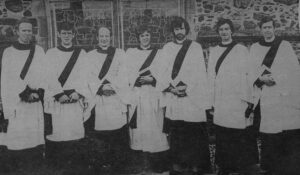
One of my friends, and someone ordained in our year, Rev. Alan Haire, pictured here second from left, committed suicide while serving in a Belfast parish in Sandy Row. I never thought Alan to be gay, but the pressures on all of us to conform, have the perfect marriages and keep up appearances destroyed many good men and women like him and his family. Human sexuality and intimate relationships were simply taboo subjects and homosexuality was often the distraction that allowed heterosexual clergy (and their congregations) to avoid talking about their own expectations and desires. After the very open and spiritually nurturing atmosphere of Bangor with its vibrant Christian community life, I found preparation for the ordained ministry in Dublin stifling and more concerned about how the seminary turned out clerical technicians. The spiritual development I needed and loving nurture would come from key elementary relationships with Frank, Malcolm, Patsy and Jonathan and the network in the U.K. that would become the Gay Christian Movement. As a seminarian, I was happily assigned to St. Bartholomew’s parish in Ballsbridge where both (male) clergy were closeted and an Anglo-Catholic veil of sacred mystery ensured the subject of homosexuality and religion would never be openly discussed. The curate drank himself to an early death and was brutally murdered years later, clearly a hate crime. John Paterson, the vicar also met an early death through cancer. Both were really lovely human beings and loved their people as faithful clergy. Yet, this toxic closeted world, where lives were diminished and ending in desperate unacknowledged tragedy, was the best the Church of Ireland had to offer folk like me in the 1980’s.
I pressed on, feeling something greater was at work in all of this and my destiny would be tied to this little church on Clyde Road in fashionable Ballsbridge, in a way I could or did not expect. In the meantime, our love letters had to be mailed to a friend’s address for fear of exposure. This was not a healthy environment to anyone struggling with sexual identity issues!
My family shared much of the homophobia that ensured any reform of the gay criminalization would be delayed for another decade in Ireland, both sides of the border. The Durham oasis, first love and a few friends in Ireland allowed something (pretty stunted until now) to begin to seek nurture and light. Frank and I were falling in love and even though a part of us remained pretty naive about the power of the institutional church, we realized there needed to be a Plan B that would allow us to be in a relationship while ensuring I had a way to make a living if the church kicked us out for being gay.
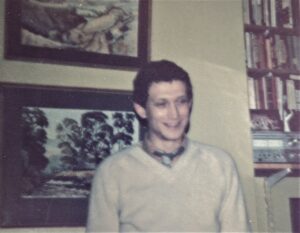
At 22 years old, I considered and was accepted to study for an Master of Philosophy degree at Trinity College Dublin, but Frank was going to study Art History in London and I wanted to be with him. (I would later return in my 50’s to finish the M. Phil at the Irish School of Ecumenics, studying International Peace Studies). The Church of Ireland would not ordain men until they were 23 years old, so my free year would be used to obtain a teaching credential at the London Institute of Education. A teaching credential in Religious Education would be useful in a parish ministry as well as give me some independence if we had to leave the church over the gay issue. This would be my insurance policy if the church kicked me out and allowed Frank and I to live together as a couple. We rented a room in Wimbledon from a lovely Quaker, named Dudley Barlow. We met him through the emerging Gay Christian Movement where Malcolm had been active with straight allies like Jonathan. Malcolm asked me to speak at a conference at Wick where the Gay Christian Movement was launched and I met some wonderful lifelong friends there like Jim Cotter, who became one of the foremost liturgists of the Anglican Communion. John Brown, the Warden of the seminary, a very closeted gay priest, allowed me to attend the Wick conference, sensing this was important to me and my future ministry. All of the staff were supportive and sympathetic in as much as they could be, given the shame and guilt associated with the “love that dare not speak is name” and their own internalized homophobia. Nevertheless, some of my media/communication and social skills, how to be a clergy technician, my love of Irish church history and elementary reconciliation were formed during that year in Dublin. Brown was encouraging as much as he could be. He represented Trinity College in awarding me the Downes Prize for Oratory and Composition after preaching a sermon in the college chapel. He, like many gifted LGBT clergy sacrificed a lot and the church benefited from their gifts and skills, but we would never be fully acknowledged and loved in the way we needed to be. Alcoholism, deep shame, self-harm and ultimately exile to England were the prizes that the vast majority of decent men (and later women who faithfully served God and God’s people) could expect. Sadly, 50 years later, the Church of Ireland is still (consciously or unconsciously) exporting some of its finest people who do not abide by these unspoken rules.
A year in London
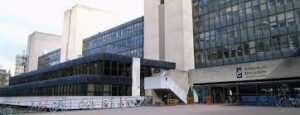
I loved studying education and specialized in the teaching of religion and art. Britain was becoming a multi-cultural society and the revolution in religious education in schools was moving away from exclusive Christian teaching to presenting some facts and introduction to world religions in schools. The faculty at the Institute were in the leading edge of this radical reformation and I loved the energy, the values implicit in teaching understanding and tolerance and how to communicate as a teacher. My thesis, at the end of the one year program, focused on Religion and Art and the dissertation won a distinction and prize from one of the London Guilds for being top of my class. Frank and I struggled with the decision about me returning to be ordained and work in Ireland but I felt a calling and knew I had work to do in reconciliation, even if it meant we would be apart for another two years.
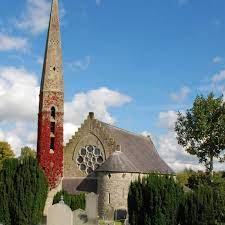
A parish on the edge of Republican West Belfast, in Derriaghy would give me a home and some relative privacy up on Colin Mountain overlooking Belfast. It’s seasoned Rector, Norman Barr was a close friend of my parish priest and the local clergy in neighboring Dunmurry provided an oasis of love, support and tolerance. John Gribben, the assistant in Dunmurry became a good friend and later would join the Community of the Resurrection at Mirfield in England.
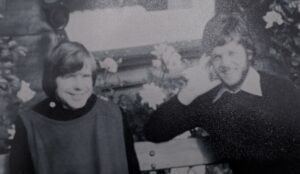
John knew about Frank, who would come home every 10 weeks when term was finished and worked in Belfast with some staff at the Ulster Museum like Dr. Eileen Black. He was getting to know the Irish art historical world and through Eileen became aquainted with Professor Anne Crookshank of Trinity College Dublin. He collaborated and researched a fairly unknown 19th century Irish painter (from Belfast) named Andrew Nicholl. Frank’s art historical background was useful and later, he helped to contribute to the Knight of Glinn’s book on the history of Irish artists, co-authored by Anne Crookshank.
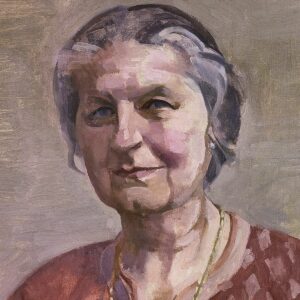
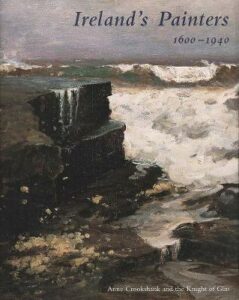
I would save up my day off a week and go to London mid-term for a couple of days to be with Frank. We suffered this for two years with the support of our friends and Frank’s family. Meanwhile I was working in a parish trying to bring some sort of reconciliation to a war-torn community. British army checkpoints were regular interruptions in our community life, bomb explosions and sectarian assassinations. My boss, Norman Barr lost his Senior Warden, shot by the IRA, just before I began working with him in Derriaghy.
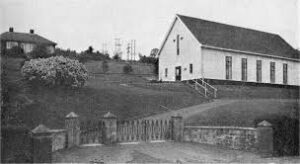
My car was stolen at 2 a.m. one frosty morning from the front gates of our little mission church on Ballycolin Road, to be used as a potential car bomb, but broke down as it was heading to the Poleglass area of West Belfast. We established a joint protestant/catholic youth club in one of the parish buildings and I was threatened by the local protestant para-military organizations who were not in favor of this attempt to build relationships between local children who attended state (Protestant) schools and church (Catholic) schools. There will never be peace in Ireland while schools remain segregated.
My mother had to be told about the nature of my relationship with Frank (after mounting pressure from her on why my brother Jim was getting married before me, the eldest). She cried for three days following that difficult kitchen table conversation and demanded I not tell my father, thinking he would blame her for making me gay. I complied. We all lived in a furtive world where no-one was really at ease, a world of unspoken truths and keeping up appearances as Northern Ireland burned itself into bloody violence and sectarianism. Frank and I decided to move to Dublin when his studies ended in London and I got a job in St. Bartholomew’s in Ballsbridge and we moved into St. Mary’s Lodge near the church. Reconciliation was still needed in all of Ireland and we hoped the south and metropolis of Dublin would give us some form of acceptance and enjoyable life together. This hope was to be short-lived when we were mistakenly outed by a friend two years later. The complex and traumatic events of what happened in St Bartholomew’s fall outside of this reflection on art, and are dealt with elsewhere.
Religion dominated everything in N. Ireland, not only for us closeted gays and lesbians who moved in and out of the shadows. Hit from both sides of the sectarian divide, there was actually a lot of ecumenical support between LGBT Catholics and Protestants. Over a couple of months, (as the recent movie “Belfast” records) a series of mob attacks in previously integrated areas in Belfast, forced mass exodus of Catholic families from Protestant communities and vice versa. This directly impacted some of my Catholic friends and a member of my own family. Belfast had seen many opportunities for integrating both religious traditions including many “mixed” marriages. Neighborhoods in the city began to reflect this tolerance and Catholic families lived beside their Protestant neighbors and in-laws, until that memorable weekend when the city was engulfed in fiery petrol bombing and intimidating families to move out of mixed neighborhoods. The city, once again, divided along old tribal boundaries and remains today in a state of benign apartheid. Schools remain institutionally sectarian and minority groups (including LGBT advocacy organizations) of all religious representations (Corrymeela Community, the Irish School of Ecumenics Trust) attempted to keep relationships open and alive. It would take 30 years of violence and thousands of deaths and thousands of wounded families to shunt and shock the terrorized community towards some form of peace process, ending in the Good Friday Agreement. Homophobia, fueled by Catholic and Protestant theological objections to LGBT people, remained part of the Northern Irish culture for several more decades. Homosexuality remained illegal in the Republic until 1993, and thanks to the leadership of Irish President, Mary Robinson and a handful of activists including Senator David Norris, things began to improve on both sides of the border. In the North, Jeff Dudgeon had the courage to take the British government to the European Court of Human Rights in 1981 to ensure the anti-gay legislation that had been repealed in mainland Britain in 1967 should apply in Northern Ireland. A strange coalition of Catholics, Protestants and Evangelicals, led by Rev. Ian Paisley, desperately tried to keep the Victorian laws and attitudes alive through the “Save Ulster from Sodomy” vicious campaign in the late 1970’s. Following our outing in Dublin and exile to London when I was fired from St Bartholomew’s, Jeff was kind enough to share some advice and experience: “Albert, if you want to spend the next ten years of your life fighting this, then remain in Ireland.” In his voice, I heard, not only a realist, but someone whose life had been completely consumed by this significant challenge to the deep seated prejudices of the majority of Northern Irish and fully supported by the churches here (excluding the very small band of Quakers and Unitarians). Twenty years after our own exile, my own beloved Church of Ireland was still exporting some of her best clergy to England (even from the progressive Diocese of Dublin) , who happened to be gay. Jeff’s advice was sadly, brilliant. I realized that moving to England and finally to the USA would be better use of my time and talents and I could be of more use to the Irish LGBT community working outside of Ireland. In the USA, mainstream Christian denominations were grappling and studying the issue of the place of LGBT people within the church and what to do about openly gay clergy. American Bishop, Gene Robinson, was consecrated as the first openly gay bishop within the Anglican Communion as late as 2003 and the back story to that historic journey became something that inspired me and so many to continue the struggle within Anglicanism. As time progressed, I began to see the events of the exile from St. Bart’s and Ireland as no longer about being thrown out of the church for being gay and in a relationship, but about another mystery of being birthed out towards something else. In the meantime, so many would continue to live in shame, in the shadows, in fake heterosexual relationships, in closets behind the sectarian divides of Irish life and clerical collars. So many would suffer and especially within two decades of the AIDS epidemic passing, thousands would die.
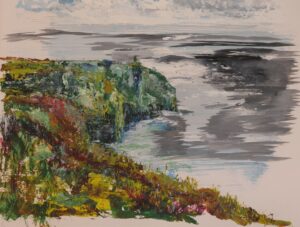
The Cliffs of Moher, West of Ireland. One of several live paintings I worked on from the summer or 2021.By 1998, death and the disappearance of young, beautiful, vibrant lives was all too common to me, after working over a decade during the AIDS crisis.
In 1985, Frank was also to be taken from us, way too soon, only 32 years old, due to complications from AIDS, the 99th person in the UK to be diagnosed with this relatively unfamiliar disease. Life, death, loss, grief, art and activism were all strands in the helix of early formation and although art would not be the dominant focus of more familiar work to many of those who know me, it still played an underlying foundation for the AIDS work I would be doing in California from 1985 to 1991 and in Africa from 1991 onwards. The next chapter reflects on “transformation” and how Frank’s premature death changed everything.